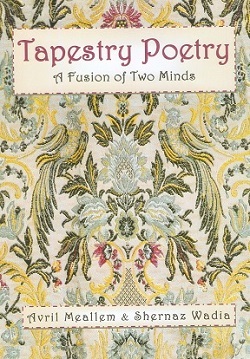Apr 23, 2024
Apr 23, 2024
Avril Meallem and Shernaz Wadia, Tapestry Poetry,
End 2 End, Pune, 2011, 110 pages, Rs 230 ISBN 978-965-91954-0-4
 Fusion of ideas, concepts and aspirations contributes to enrichment and progress. Two poems on the same theme by two who worked together to come up with a tapestry lacing the poems together into one is opening a new vista and inauguration of a new genre. And then there is femininity at the base.
Fusion of ideas, concepts and aspirations contributes to enrichment and progress. Two poems on the same theme by two who worked together to come up with a tapestry lacing the poems together into one is opening a new vista and inauguration of a new genre. And then there is femininity at the base.
I am reminded of the Sanskrit words of Mammata Bhatta, the ancient poet of 11 th century A.D., who wrote Kavyaprkaasha in which he averred that Kavya – read poetry – is one with the gentility of a woman and her preaching (kantaasammitayaupadesayuje).
Tapestry Poetry is a product of imagination, labour and skill – beautiful to look at and sweet to ponder on, thoughtful, thought provoking replete with the basic tenet of femininity. The two poets of the work under review are unique in many ways. First they are two nations, two faiths, and two professions. The first is a Briton, shifted to Israel, a Hebrew by faith and a therapist by profession. The second is an Indian, a Parsee and Zoroastrian by faith, a primary school teacher by profession.
Their themes are natural everyday ones: trees, flowers, rain, river, sound, silence, light, shadow, illusion, hatred, hope, understanding and peace. Their tropes and symbols – all display the basic tenet of femininity again.
Unknown may be the poet, and unseen by many a reader, the poem communicates, displays and reveals the poet’s mind, imaginative conception and expression. Two minds working in the harmony of understanding and producing an artefact is a delight to look at appreciating their work. The two must have spent days in constant innovation, creativity and imaginative exuberance though living thousands of miles apart.
It is pleasantly surprising that the two are devout, imaginative and innovative. With fabulous femininity they unveiled it to the reader’s understanding and deep sense of appreciation. Though belonging to two different geographical regions, born of two entirely different speeches and practices of faith, they produced a distinctive work of imaginative/expressive art.
Femininity and devoutness are inbuilt in their traits and attitudes of the mind. Of these two poets, one is a Parsee born and living in India and the other a Briton gone to Israel following the faith of the natives of Israel and Jerusalem.
Here is a sample which goes to the heart of the matter. On the subject – call it a theme if you will – of wavelength. Each has written a poem in nine lines and later interacted and collaborated too to furnish the best possible message in eighteen lines. The printed book is so designed that the works of the two are on the left and the finished artefact on the right.
On the Same Wavelength
I write
Words flow, but will you understand?
Can my thoughts touch yours,
enter your heart
as they flow from mine?
Can we merge as one unity.
Connect on the same wavelength
to soar through the universe
on a single song? (Avril)
miles and cultures apart
we still vibrate
on the same frequency
across distance
we share the same space
how amazing!
kindred spirits
we met a purpose to fulfil
let us rejoice and celebrate (Shernaz)
On the Same Wavelength – Tapestry
I write.
Words fly across distances
but miles and cultures apart,
will you understand?
Can my thoughts touch yours
on the same frequency?
Enter your heart
as they flow from mine?
Yes, it is amazing,
for we do share the same space,
connect and vibrate
on the same wavelength.
As kindred spirits,
let us rejoice and celebrate
as we merge into one entity
and soar through the universe
on a single song; a new purpose to fulfil. – (Avril and Shernaz)
The foreword and the blurbs were well provided to whet the appetite of the forthcoming readers. Friend Kumarendra Mallick made a solid statement saying Kipling’s words have been proved untenable – now the twine, the East and the West met and met with a twang. As he felt and said the duo opened a new vista and a new genre of poetry has emerged.
In the blurb Ruth Fogelman revealed to us ‘In Hebrew the number 18 signifies life: these tapestries reveal the inner life of the soul…’ Added Gretti Izak about the sum and substance of the work: ‘Here are two poets who meet, like each other and decide to experiment by combining and merging their individual poems together.’ He explained the difficulties they in their effort must have surmounted.
Femininity is the hall mark of this affectionate work. To begin with it is the dedication – to the beloved children first and then filial duty to the parents. Their themes and tropes are meaningful with no sense of pride. In all there are forty-five items in the thoughtful exposition of this brave new endeavour.
26-Sep-2015
More by : Dr. Rama Rao Vadapalli V.B.